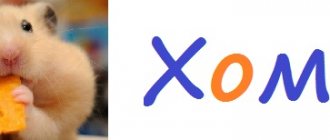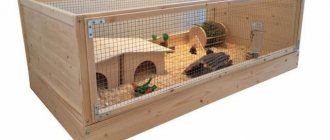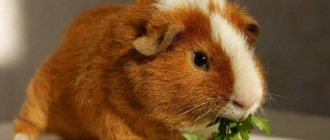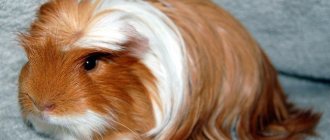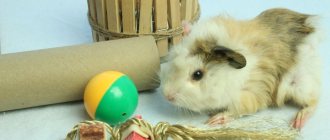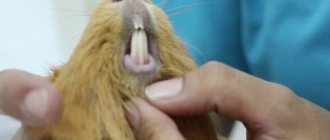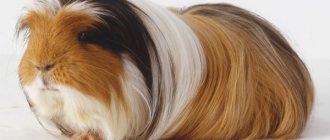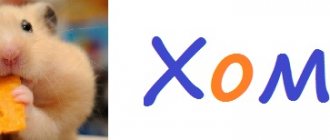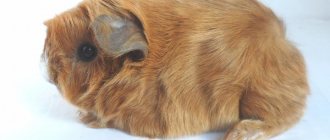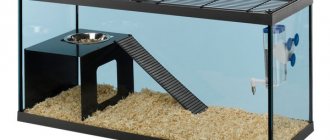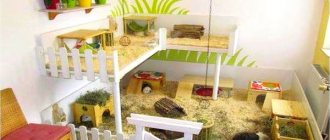- home
- Guinea pig
- General information about guinea pigs
02/15/2019 Few people know that guinea pigs are trainable and can learn dozens of tricks. They are taught commands of varying degrees of complexity. The secret of training lies in the patience and perseverance of the owner. The result depends on the pet itself. Some animals learn information faster, others slower, or even like to be stubborn. If the owner adheres to the correct algorithm for processing commands, his efforts will be crowned with success.
What you need to know
Guinea pig training is based on using the animal's natural behavior as the basis for training. The action that the pet performs is preceded by a sound signal (verbal command, click, whistle), and reinforced with encouragement. The behavior and reactions of each pig are individual, so before training you should study the pet’s character and get to know him better. Give him the opportunity to get used to the owner and his hands. Demonstrate good intentions with calm demeanor and occasional treats. The optimal time for getting to know each other is 2-3 weeks from the date of purchase of the animal. After this, you can begin training.
Training is carried out subject to the following conditions:
- Coordination with feeding schedule. The pet is more willing to work for a treat when hungry.
- Calm environment. Exercises will be more successful in the absence of external stimuli - people, animals, TV.
- The animal is on a hard surface - this way it feels confident and is less distracted.
- The duration of the lesson is no more than 10 minutes.
A word, whistle or clicker is used as a command. Over time, the pig will get used to associating the sound with a certain action.
During exercise, the pet and owner should be in a favorable state and show no signs of fatigue or irritation. A bad mood will complicate the task for both parties and will not lead to positive results.
Types of guinea pigs
There are more than two dozen breeds of guinea pigs - from the classic “rosettes,” as breeders call them, to luxurious long-haired Peruvian, English, alpacas, etc. The most original in appearance can be called, for example, curly Texels or Sheltie pigs - their long hair looks like it is combed back. Himalayan pigs are very interesting - they are called “Siamese” due to their color, like Siamese cats. Well, we can’t help but mention skinny pigs: this is a breed of sphinx pigs that have practically no hair.
Caring for pigs
When it comes to care, all pigs are practically the same - they need to regularly change trays with sawdust or other filler, feed them tasty food and brush them. The longer a pig's fur, the more difficult it is to care for: you need to comb, wash and cut. Especially long-haired or show pigs need professional grooming: they are washed with hair conditioner, thoroughly combed and fashionably trimmed. Pig luxury!
Taming
You should not constantly handle the pig immediately after purchase. The pet is given time to get used to the new environment and strangers. If the animal is very nervous, the cage is covered with a translucent blanket. This creates the illusion of privacy and the animal relaxes.
After a few days, they begin to carefully pick up the animal. Hold it tightly enough, but not too tightly, otherwise it will hurt the pig. The second hand is used to support the pet from below. This will help the animal feel stable and safe.
You need to talk to the pig often and say its name. Use a soft and friendly tone. From time to time the pet is offered treats. All this creates a positive image of the owner in the animal’s head. He will understand that this person is not dangerous. Depending on the character of the animal, taming takes from 2 weeks.
Guinea pig in heat
Domestic guinea pigs can give birth at any time of the year, but conception occurs only at a certain time - when the female is in estrus. Estrus begins every 2-2.5 weeks and lasts approximately 48 hours. The most favorable time for conception is considered to be the first 12 hours of estrus.
To start breeding guinea pigs, you need to be able to recognize the period when the female is ready to breed.
What does a rodent look like during estrus:
- the pet's genital loop increases in size;
- a mucous secretion is released from the vulva;
- when stroking the female raises her butt;
- the animal purrs invitingly and arches its back;
- When meeting a male, a female does not show aggression and accepts courtship.
Upbringing
Guinea pigs begin training after the pet gets used to the owner and begins to trust him. First, simple commands are taught, moving on to complex ones.
One of the first lessons is the ban on damaging objects and furniture. When a pet finds itself outside its usual cage, it is naturally drawn to inspect everything and test its teeth. If the animal shows increased interest in wires or the same object, a spray or gel with a bitter taste is applied to these things. Such products are sold in pharmacies and are safe for animals.
In addition, a running pig should be kept in sight at all times. She can not only damage something, but also accidentally injure herself. The cage with the pet is placed away from curtains and other objects that the animal can freely reach. The lock of the cage must be reliable and strong.
Additional tips and tricks
Guinea pigs are easy to care for. It is enough to equip the cage correctly, feed it delicious food, and the pet will be happy. But training enthusiasts will need to establish contact with the future artist.
You can tame a guinea pig to your hands only through daily exercise for 20–30 minutes. The rodent should be held in your arms, stroked on the back, and scratched on the tummy.
Pets love to stretch their legs and travel around the apartment. The main thing is to keep an eye on them, otherwise they may chew on electrical wiring or hide in a secluded place.
There is an opinion that taming guinea pigs is a thankless task. In fact, animals are capable of performing simple tricks if you follow the rules of training. Patience, care, and delicious food will help the animal master simple commands based on a conditioned signal.
Toilet training
Keeping a pig at home requires frequent replacement of bedding. The process is simplified if the animal is accustomed to relieve itself in a tray, which is easier to wash than the cage tray.
Training takes place according to the following algorithm:
- A tray is installed in the cage in the area where the pet goes to the toilet.
- A little filler, soiled sawdust and pig feces are placed in the tray so that the pig can identify the purpose of the new item by smell.
- Give the animal a treat if it relieves itself in the right place. It may take him some time to do this.
It is worth remembering that some pigs do not like using the litter box. In such cases, training will not help. It all depends on the character and preferences of the pet. As a last resort, try installing additional trays in other corners of the cage. If the animal uses the tray as a house - carries hay and sleeps inside, you need to buy a regular house or exchange the existing one for a more spacious one.
How to properly trim a guinea pig's nails
- First of all, the pet must be removed from the cage safely, slowly and without sudden movements, so as not to anger the pet;
- After this, the animal needs to be wrapped in a towel so that it is comfortable, and placed on your knees with its back to you to avoid bites;
- After placing the guinea pig, you should pull the paws out of the towel one at a time and treat each one separately;
- Having secured the claw between your thumb and forefinger, you need to take the device with your free hand and carefully trim the claw without touching the vessel.
- If blood does appear, you should immediately use a hemostatic powder;
- If, after completing the haircut, there are uneven areas on the nails, you should treat them with a nail file;
- After the procedure, it is recommended to replace the bedding so that dirt from soiled sawdust does not get under the rodent’s trimmed claws.
How to make the procedure as painless as possible
To understand the exact location of the vessel and not touch it, you can illuminate the claws with a lamp or flashlight and trim only the transparent tip
If your rodent's claws are dark, you can carefully use a nail file to file down the tips.
So that your pet’s paw can stand straight, you need to cut the claws at an angle without touching the vessel; A rodent should be accustomed to trimming its claws from childhood, one month, then it will get used to it and will stop worrying with age. To prevent bites, you can put a muzzle on your rodent for miniature dogs. The nails should be trimmed sequentially, moving from one finger to the other, starting from the edge.
If it’s difficult for one person to hold a pig and trim its claws at the same time, you can try together – it’s faster and more effective. If one holds the rodent, it will be easier for the other to handle the nippers. It is necessary to carry out the procedure regularly, because in case of strong regrowth, the trimming process will be more difficult, and the animal will suffer from deformation of the paws.
What to do if your pig is worried?
You need to understand that this is quite a stressful situation for the animal and you need to be prepared for its anxiety
It is important to carry out the procedure quickly, but more importantly, carefully
If your pet doesn’t want to obey at all, you can trim his claws in the bathroom or kitchen by turning on the water; at this sound, the guinea pig will simply freeze.
When the owner of a pig has doubts about whether or not it will be possible to trim the claws himself, you can contact a veterinary clinic.
Special scratching posts are sold for guinea pigs.
Training to drink
Many pigs themselves understand the principle of operation of a mounted drinker; they do not require special training for this. As soon as they touch the ball, moisture comes out and they lick it off. This movement puts the drinker into action again. But some pets are afraid to touch an unfamiliar object. In such cases, the owner's help will be required. You need to touch the ball yourself and make the water come out. Then bring the animal closer so that it smells the moisture and tastes it.
If your pig hasn't used a water bottle for a while, she probably needs enough moisture from the succulent food included in her diet. She'll drink whenever she wants.
Why does he drink a lot?
There are many reasons why guinea pigs drink heavily. One of them is pregnancy in a female. In this position, the guinea pig drinks a lot of water. Another reason is illness. A hamster may drink a lot due to elevated body temperature. This replenishes all the necessary elements in the body. In winter, when houses are heated and the air dries out, guinea pigs' need to drink increases. In winter, pigs' diet changes. For the most part, they are fed hay, formula, and dry food.
Therefore, it is very important to feed your guinea pigs in a balanced manner, adding more vegetables, herbs and fruits. They contain moisture, which replenishes their fluid
Hyperactive rodents that run and play a lot also require plenty of fluids. The animals are quite sensitive and can experience overexertion. This is also the reason for frequent drinking in the animal.
Team training
Guinea pig training begins after the pet gets used to the owner and begins to trust him. In conditions of tension and stress, learning will not bring results. Commands are given in a calm voice, even if the pet does not understand for a long time or is stubborn.
Stand
Training is carried out on a hard surface. The pet is shown a treat and raised above its head so that the animal has to stand on its hind legs. At the same time, the command is pronounced: “stand” (or use the words “up”, “serve”). As soon as the animal has straightened up, it is given a treat and praised.
To me
The pig is seated not far from you, shown a treat and pronounced its name (or the command “come to me”). You can accompany it with a hand movement - patting the leg, as is the case with dogs. When the animal runs up, it is sure to be treated. Gradually, the distance between the owner and the animal is increased to several meters.
U-turn
To practice this command, hold the treat just above the pig’s head, then slowly make a circular motion so that the pet, following the hand, turns around its axis. If an exercise turns out to be difficult for an animal, it is rewarded for partial completion - for example, for turning 90 degrees, then 180, and so on.
Kiss
The owner squeezes a treat or a little hay between his lips, then leans towards the pig. She smells food and reaches for it. Over time, the animal will perform this movement reflexively, even if the owner does not have any treats.
Give me your paw
The trick is learned using both hands. One holds the treat in front of the pet, slightly above its head; the second is placed palm up opposite the animal’s eyes. The owner says: “give me your paw,” and demonstrates the treat in such a way that the pig can only take it by rising on its hind legs. At the same time, she will place her front ones on her palm, which is located directly in front of her and prevents her from getting food.
Roll the ball
This exercise uses a treat in the form of hay or a vegetable cut into strips. A ball is placed on top of the food and the pig pushes it with its nose to move it away from the treat. At the same time, you need to say: “push the ball.” The ball used is a tennis ball or a small rubber one.
Jump through the ring
The ring is placed in front of the pet's muzzle. On the other side of him is a treat. To get food, the pig will have to go through a hoop. The words used as a command are: “in the ring.” It is permissible to gently push the animal if it is afraid to perform the trick. To do this you will need the help of a second person.
Take a large ring, at least 15 cm in diameter. At first, hold it low so that it touches the floor. Over time, they are raised, but not higher than three cm. You can use store-bought or homemade ones - made of wire or thick cardboard. The edges of the product must be smooth.
Learning difficult tricks
Guinea pigs are capable students. Trained rodents clearly know the sequence of performing the act: command-action-treat. Training is based on the formation of conditioned reflexes that help perform the task correctly.
The result will not be long in coming if people follow the basic principles of domestication:
- Interest. Rodents love to eat, so the main incentive for them is tasty food. Slices of fruits, vegetables, and dried fruits are suitable as treats. Observing your pet will help you understand which of the proposed products is of particular interest.
- Sound signal. Each trick during training must be reinforced with a certain sound (word, whistle, knock).
- Action. Guinea pigs are not particularly flexible or graceful, so you should not expect complex maneuvers from them. The pet should like the game.
- Increasing difficulty. Training begins with simple techniques. The actions become more difficult when the previous tricks are fully mastered.
Weasel helps in mastering skills. The peaceful atmosphere, smell and calm voice of the owner set the pet up for communication. Conditioned reflexes are easily developed by careful handling of the animal.
Important! At the end of the training, the artist must certainly receive a treat.
Give me your paw
In nature, guinea pigs do not push food towards themselves with their paws. But you can train an animal to perform a trick with the help of a cunning maneuver. One palm is brought to the pet's face, the other is held with a treat. To bite off a piece, the pig will have to place its paw on an outstretched palm. During training, the command “give me your paw” should be heard.
Football player
Guinea pigs play football in an original way: they hit the ball with their muzzle. A beginning football player is not fed for 8–12 hours before training.
Training is carried out in a spacious enclosure. The size of the ball doesn't matter. The main thing is that it is light. Place a sprig of greenery under the ball and wait for the pet to smell the treat. To take food, the animal will roll the ball to the side. During training, the command “roll” should sound. Gradually the pig will learn to roll the ball around the entire pen.
Jump through the ring
The trick can be done by an experienced circus performer. The owner places a ring (diameter 20–30 cm) between the pet and the treat. When the “ring” sound is made, the guinea pig is gently nudged so that it steps over the lower rim. During training, the ring is raised to a height of 4–5 cm.
On the shoulder
Rodents love to watch what is happening from above. Lure the pig onto your shoulder with the help of goodies. It is important that the animal makes the journey on its own. If you put him on your shoulder, he may get scared.
Interesting! It is better to put long hair in a ponytail while the guinea pig is getting used to walking on its body, so as not to be left with a short haircut.
Features of feeding
In the wild, hamsters feed on plant seeds, nuts, herbs, and gnaw branches of bushes. Sometimes they eat insects or their larvae. At home, the rodent is fed grain mixtures, which include:
- millet;
- barley;
- millet;
- lentils;
- buckwheat;
- peanut;
- sunflower seeds;
- pumpkin seeds;
- raisin.
You can and should give your rodent wet food. These are vegetables - carrots, cucumber, cauliflower, broccoli, zucchini. A sour apple is allowed as a fruit. Domestic hamsters love to eat grass - dandelion leaves, young nettles, plantain.
Once a week you can offer your pet boiled chicken breast and an egg without adding salt.
There should be a lick stone in the cage. With its help, the rodent will compensate for the lack of minerals in the body
It is important to ensure that the drinking bowl is filled with clean water
How to transport a guinea pig in winter
Transporting a guinea pig is not so easy: for shy piglets, traveling is always a lot of stress. Be sure to insulate the carrier: put a scarf or blanket, add a large amount of hay
It is important that the carrier is spacious enough, especially for long trips. Don't forget about food - pigs can't go hungry, so stock up on treats
Even if it's cold outside, do not place the carrier near heating appliances! It’s better to just throw more hay on top of the pig and wrap the carrier in a scarf.
Sea pigs are quite willing to learn different tricks and in general can do a lot of things, you just have to work with them a little. Don't overwork your pig: 10-15 minutes a day is enough for training. A little patience, and your furry friend will delight you with his success!
https://msvinkam.ru/soderzhanie/kak-dressirovat-morskuyu-svinku.htmlhttps://nalugah.ru/zhivotnovodstvo/morskie-svinki/kak-dressirovat-morskuyu-svinku-obuchaem-i-priuchaem-pitomca.htmlhttps: //vokrug-nas.ru/kak-dressirovat-morskuyu-svinku-v-domashnih-usloviyah/
Rolling the ball
We have already figured out how to train a guinea pig and teach it simple tricks. Now it's time to move on to the next stage. Now we will tell you how to teach a pig to roll a ball. First you need to do a little preparation. You need to find a ball that is not too heavy and not too big. For example, it could be tennis. A guinea pig can easily handle such a ball. In addition, you will need a flat and long treat. A strip of carrot is suitable for these purposes.
So, now let's move directly to the training. Place a carrot strip on the floor, then place a ball on it. After this, encourage the rodent to push the ball away so that he can get to the treat. At the same time, say the command “Push the ball.” You need to repeat these steps regularly. After a while, it will be possible to remove the treat from the learning process. The rodent will be able to roll the ball without it.
What food to give your guinea pig
Guinea pigs eat a variety of foods and greens. According to the recommendations of experienced specialists, the pet’s diet should be varied and balanced. ½ of the total menu should be hay. The remaining 50% of the diet is dry food, succulent food and greens.
Dry food
Dry food includes grain crops and factory-produced granulated mixtures (special food for domestic guinea pigs).
Healthy grain feeds:
- millet;
- barley;
- sunflower seed;
- oats;
- corn grains.
Ready-made mixtures may contain vitamin complexes.
Grains should be in the guinea pig's diet every day and should always be freely available to the pet.
Hay and branches
Hay is the most useful and necessary product for guinea pigs. It improves the functioning of the digestive tract and prevents the development of intestinal diseases, and also helps to grind down the back teeth.
What kind of hay to give your pet:
- fresh, with a natural grassy smell;
- free from dust and other contaminants;
- small bundles (can be pre-cut or rolled into a roll);
- without coarse and large branches.
This food also needs to be given to your guinea pig every day. You can make hay yourself or purchase it ready-made in a store.
Green food
Another important product in the diet of domestic guinea pigs is green food. This is meadow or field grass grown in ecologically clean areas (away from polluted road areas).
Green herbs contain many useful and nutritious substances necessary for the healthy functioning of the body of guinea pigs. In addition, these animals happily eat fresh herbs, as well as equally healthy greens - spinach, dill, parsley, celery, lettuce, etc.
Healthy green food for guinea pigs:
- plantain leaves, dandelion;
- clover;
- cilantro;
- carrot tops;
- yarrow;
- chamomile, etc.
Juicy food
Juicy food for guinea pigs includes fruits and vegetables, as well as some berries, served to the pet as a tasty treat.
What juicy foods can you give:
- beets (fodder, red);
- fresh cucumbers;
- cauliflower and Brussels sprouts;
- carrot;
- Bell pepper;
- tubers and leaves of earthen pear;
- apples;
- garden sow thistle;
- corn cobs;
- zucchini;
- tomatoes;
- grapes (seedless only);
- pumpkin;
- green peas.
As a delicious dessert, you can sometimes pamper your pets with raspberries, wild strawberries, currants, strawberries and tangerines, which are rich in vitamin C.
Treats and vitamins
The body of guinea pigs especially needs vitamin C, so foods rich in ascorbic acid must be present in the daily diet of rodents. Salts and calcium are also important for them. To saturate the body with useful minerals, it is recommended to use special mineral stones from the store.
Healthy treats for guinea pigs:
- dried fruits;
- fruit slices;
- wheat bran;
- fresh cherry branches;
- mint;
- pea pods;
- peeled flax, sesame, pumpkin, sunflower seeds.
